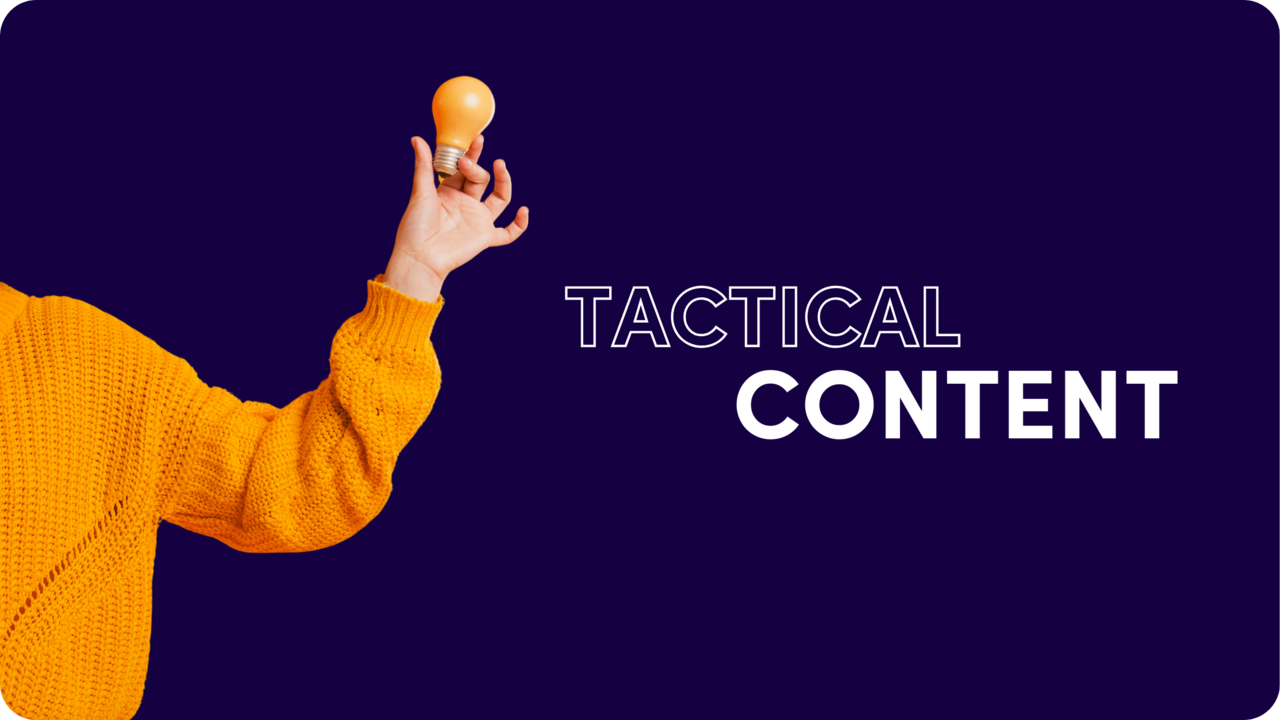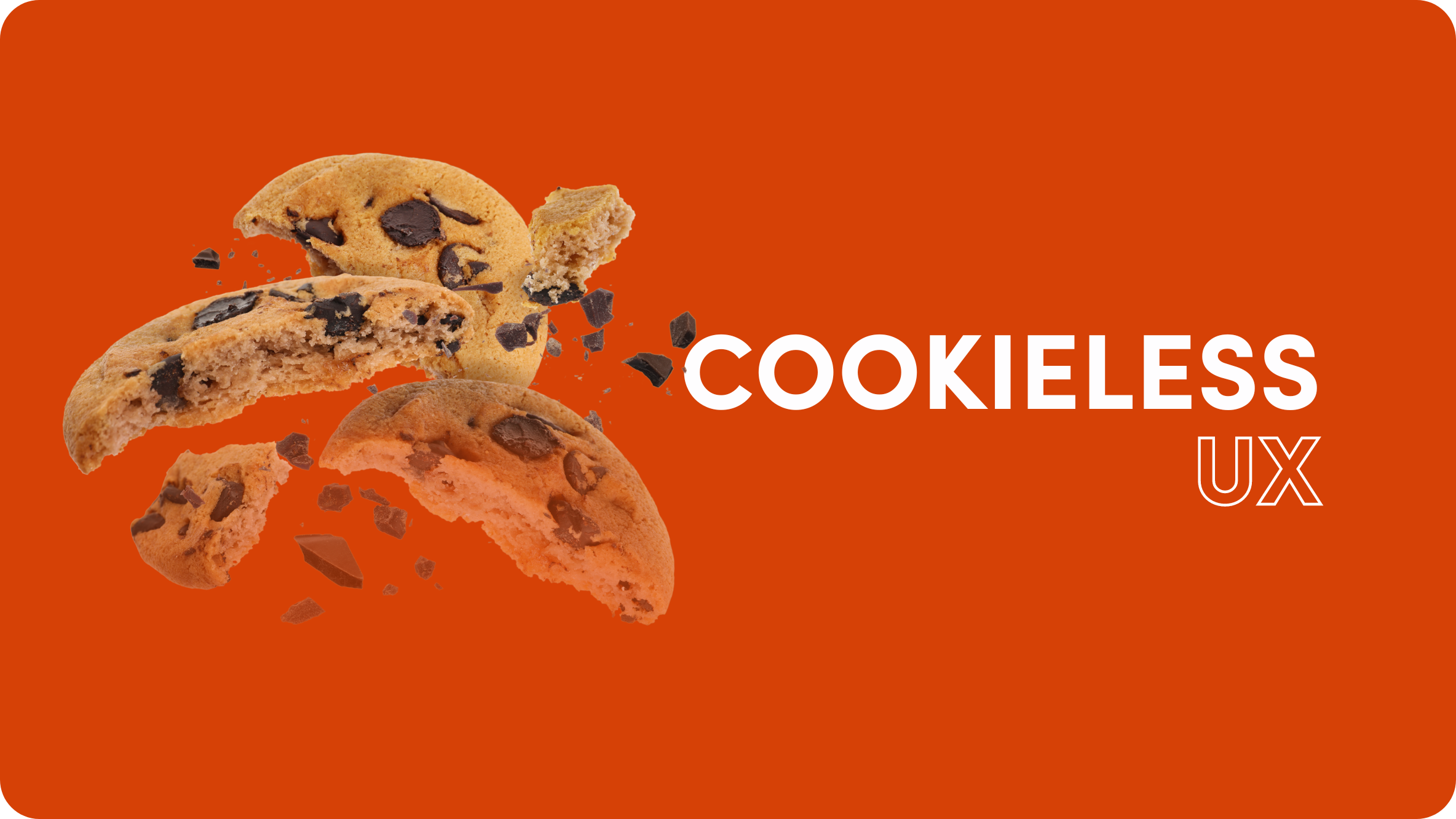15 Content Marketing Tactics You Can Try (With Tips and Inspiring Examples)
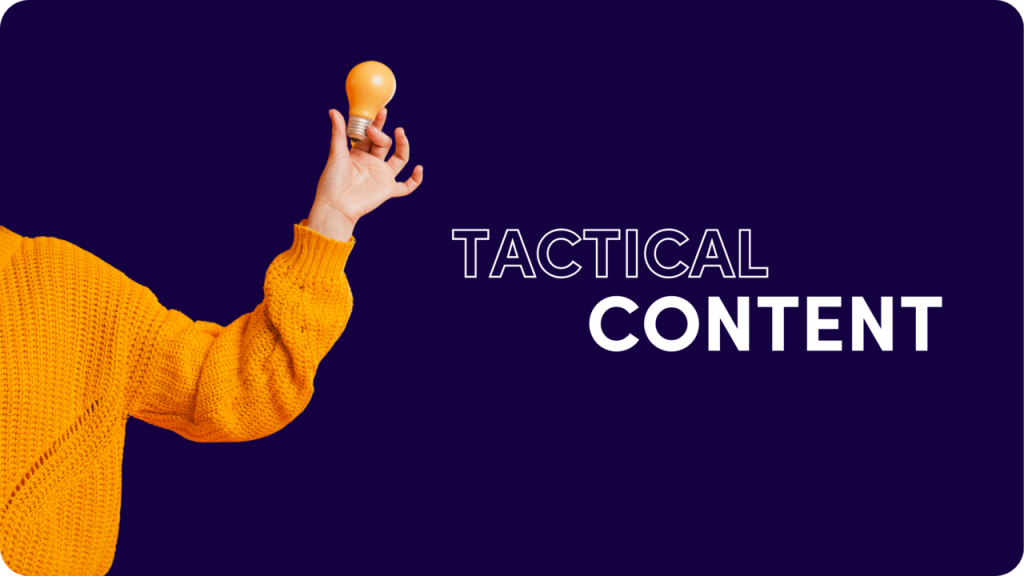
Just a few years ago, digital marketers were constantly bombarded with the cry of “content is king!”
Let’s face it, over the past decade, the internet has exploded in size and volume. In 2013, 9 zettabytes of data were generated online; by 2023, this figure had increased more than ten-fold, to 120 zettabytes!
So, while content may be king, it is also true that too much of a good thing can be…bad.
Information overload and banner blindness are real problems. At the same time that people’s attention spans are getting shorter, more content is being generated and promoted every day.
In a saturated marketplace with an oversupply of content and impatient audiences, how can you succeed with content marketing?
By being creative and mixing up your strategy with a variety of content types and tactics. Remember, if your content is exciting and interesting to you, it will also excite your readers.
From infographics and webinars to evergreen posts, let’s cover 15 content marketing tactics you can use to engage your audience, boost your online presence, and achieve your marketing goals.
1. Blog Posts
Blog posts are a must-have content marketing tactic. There are so many benefits to publishing blog posts: they are essential for SEO, great for brand building, and an excellent way to communicate with existing customers and potential customers. Another advantage of blog posts is how versatile they are: thought leadership articles, listicles, how-to blogs, long-form, short-form, vlogs (blogs in video format), and everything in between. The tough part is getting started with your first blog post, but once you’re up and running, you’ll soon see the positive impact.
Tactics for content marketing with blogs
- Boost your blog’s search rankings with an SEO optimization tool. Semrush, Ahrefs, and even Google’s Keyword Manager are examples of free resources for keyword research.
- Continually analyze your posts to determine what’s performing well. Is there a particular post that got lots of traffic and high time on page? Try to recreate the results with a similar format on a different topic.
- Don’t be afraid to give old posts a refresh. Pick a post from a couple of years back that performed well and optimize it with new data or talking points. Blog posts that already achieved good SEO rankings in the past should be kept up to date, and their value will only increase.
A little inspiration
Check out this post at Of Dollars and Data, the personal finance blog. It’s well structured, there’s clear evidence of keywords, and it offers a unique and thoughtful point of view.

2. Videos
If content is king, then videos are right alongside it. Video has become the most popular content format, and there are several reasons why. Video is more emotionally engaging than text, and it is easier to consume. With people spending more time on mobile than ever, video is easier to engage with on a small screen, and more suitable for on-the-go content consumption. Plus, the ‘short’ video format popularized by TikTok and YouTube Shorts has ‘trained’ a generation of consumers to expect quick, easy videos when looking for products or checking out the latest news and entertainment.
Online video creation tools, including some incredible new developments in AI video generation, have reduced the investment needed to produce good-looking videos. Videos will become more cost-effective over time, so there is no reason not to focus on videos as a solid content marketing tactic.
Tactics for content marketing with videos
- Make sure your video titles and descriptions are optimized for search. They help you get found on search engines and are a great way to serve your SEO strategy.
- Videos are made to be shared, so share them. Share them on social media, your website, YouTube, or anywhere your target audience could be.
- Tell a story. Storytelling takes the viewer on the journey with you so they are more likely to keep watching to the end. Even short videos can have an engaging story.
A little inspiration
We take a lot of inspiration from Nike’s videos; they are some of the most powerful brand-building devices we’ve ever seen. And the one below is a good example. The production value is high, the story is compelling, and it’s the type of video you watch and rewatch over and over.
3. Infographics
Infographics are a popular content marketing tactic due to their visual appeal, which captures attention and simplifies complex information. Infographics are highly shareable across digital platforms, making them good vehicles for brand awareness and reach. Additionally, infographics offer SEO benefits by generating backlinks and improving web traffic. Use infographics to communicate different information at different points across the marketing funnel in an impactful and memorable way.
Tactics for content marketing with infographics
- Create infographics that are informative and simple to navigate, not cluttered with a bunch of symbols and images.
- Make sure to optimize your infographic’s SEO for image search. Infographics are great magnets for search queries and can help drive traffic to your website.
- Infographics can be used anywhere… and should be! Ensure you share them on social media and use them in blog posts to create engagement.
A little inspiration
At Outbrain, we wanted to explain the history of native advertising without getting bogged down in boring stats and facts. So we created an infographic about it that has stood the test of time.

4. Podcasts
The global podcast audience is over half a million people. Podcasts are one of the fastest-growing content types, and there are several reasons why people tune in, including learning about a topic, hearing different opinions on a topic, or having something to listen to while doing something else. Whatever the reason, creating podcast content might be a good tactic if you have a large potential audience that is eager to engage. With the right tools and setup, it is not difficult to record podcasts and distribute them without a fancy studio.
Tactics for content marketing with podcasts
- Include guest speakers as part of your podcast strategy. Consider inviting industry experts, thought leaders, and influencers who may have something to say that your audience will value. This will attract more listeners to your show.
- Promote your podcast on various channels, including your blog and website, social media pages, and native ad campaigns. This ensures you draw the largest possible audience.
- Add a transcript of your podcast to your website. It makes for great SEO and provides an alternative way for people to consume the podcast if they can’t or don’t want to listen to it.
A little inspiration
The Content Strategy Podcast is a great example of using an audio show to promote your brand. Kristina Halvorson is the CEO and founder of Brain Traffic, as well as the founder of both the Confab and Button conferences. Her show discusses all things content with special guests and is an excellent promotional tool for her business.
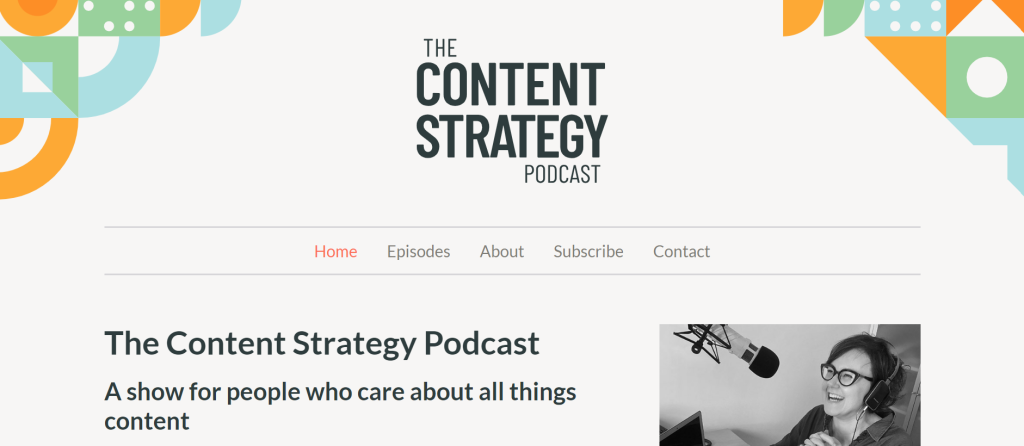
5. E-books and Whitepapers
E-books and whitepapers are a favored content marketing tactic particularly for B2B companies, as they provide the space to dig deep into a topic and provide a lot of information, expertise, and value. E-books and whitepapers are useful for lead generation – people can download the content in exchange for their contact information, which is used in future marketing campaigns. People are often willing to provide their personal details if they feel they are receiving something worthwhile in return. The long-form, in-depth format is ideal for educational marketing strategies that nurture potential customers without hard selling.
Tactics for content marketing with e-books and whitepapers
- An e-book or whitepaper demands more expertise and detail than a blog post, so recruit the right people from within the company to support you with relevant, valuable insights and information.
- If you decide to gate your content behind a form, make sure the process is easy and quick. If the user has to complete a lot of details, they may get turned off. It is not uncommon to require just an email address and nothing more.
- Promote your whitepapers and e-books on social media networks where the audience is likely to spend their time. You can even create messaging campaigns on social to approach prospects individually or send the e-book to your existing email distribution list to encourage engagement.
A little inspiration
Great e-book content is ‘edutaining’. It provides a valuable resource for information while also being a little fun and engaging. We love this example of Guesty’s vacation rental marketing guide. The e-book is comprehensive, with 36 pages, but it is also easy to read and jam-packed with information in a cool, blue design.
6. Case Studies
Case studies can showcase real-world applications of your business, which builds trust and credibility. At the same time, you can segment case studies for different customer types or goals, addressing specific markets. Case studies are very relatable and if you use a storytelling style, they can provide entertainment value too. Case studies may be the ultimate form of social proof, uplifting the brand by association. Creating a solid case study does not require a lot of resources or budget, but it does require a good relationship with customers who will agree to tell their success story for you.
Tactics for content marketing with case studies
- Think out of the box – try to choose customers who had an unusual or intriguing success with your company. Also, vary the theme of the case studies to include different products, working methods, and results. It is important to provide a holistic impression of the capabilities of your company.
- Make sure you’re using real customer testimonials and data. It may tempting to alter a quotation here and there or boost a number, but this is unethical, and being exposed as doing this will damage your brand beyond repair.
- Share your case studies on your website and in sales presentations. They’re a fantastic sales tool and go a long way to building trust.
A little inspiration
On the Outbrain case studies page, readers can filter by industry and/or business objective, so they can easily find a case study that is relevant to them. We love how Laura Geller Beauty brand achieved 174% ROAS (return on ad spend) with Outbrain ads. This customer’s story is just one of the many we highlight on our website, and it’s gone a long way to building customer trust.
7. Webinars and Online Events
Webinars and online events are super valuable because they enable you to interact meaningfully with customers in real time, and also provide instant analytics about engagement and interest. While webinars are a more resource-heavy endeavor, the value of these insights is huge. Webinar content has a far longer shelf life than just the webinar itself. You can re-use sections and snippets to promote elsewhere, and you can feature the webinar recording on your website for later viewing by a broader audience. Webinars and online events can be attended by anyone, anywhere, so the audience is not limited by location.
Tactics for content marketing with webinars
- Make sure your webinars feature a Q&A session. Guests love to hear an expert speak but also have a chance to understand how what that speaker has said will impact them.
- Record the live webinar and repurpose the video as on-demand content.
- Collaborate with influencers or special guests to bring more attention and sign-ups to your webinar.
A little inspiration
The team at Wix.com are experts in running online events and educational webinars for their target audiences. For example, this webinar about technical SEO was a one-off investment to create and publish, but it continues to reap rewards, permanently featured on the WIXLearn website.
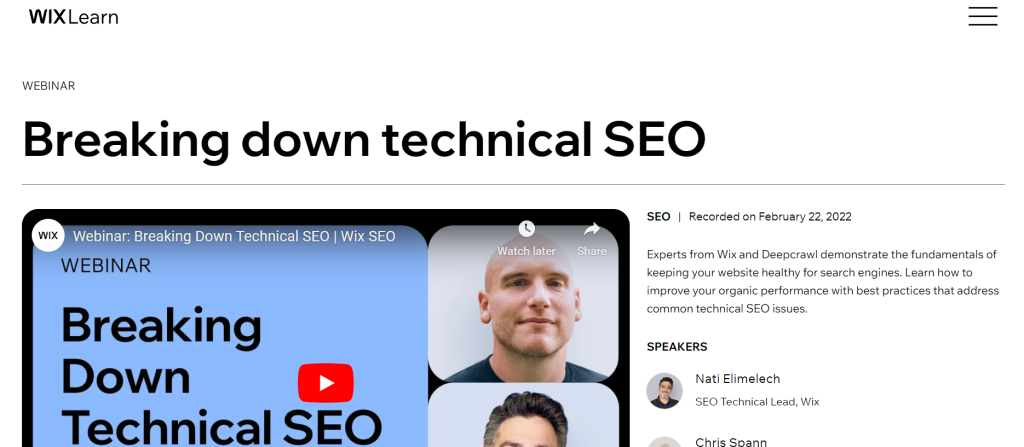
8. Interactive Content
Interactive content includes things like quizzes, polls, and surveys, which encourage audience participation, making them much more engaging than static content. Creating interactive content requires an added layer of creativity. A poll that is relevant to the audience and perhaps even tackles a controversial issue will be naturally exciting to the audience, as they will be motivated to add their opinion and curious to see the opinions of others. Use online tools for content gamification to boost your audience’s interest and interaction with your content.
Tactics for content marketing with interactive content
- Audience engagement can only happen when your content is exciting and compelling. Make your quizzes and polls tricky (but not too tricky) and though provoking to draw the audience’s interest.
- A side benefit of interactive content is the data it provides. For example, poll results and quiz responses provide important insights about the audience’s state of mind. Use that information to your advantage!
- Share results and insights with your audience. This increases the interactivity and makes the connection with the audience even stronger.
A little inspiration
Here’s an example of a LinkedIn poll by Maury Rogow, CEO of Rip Media Group. He asks the audience a simple yet personal question that is relevant to the industry and also provides insights into the opinions of individual respondents. This kind of interactive content takes only minutes to create but garners powerful engagement.
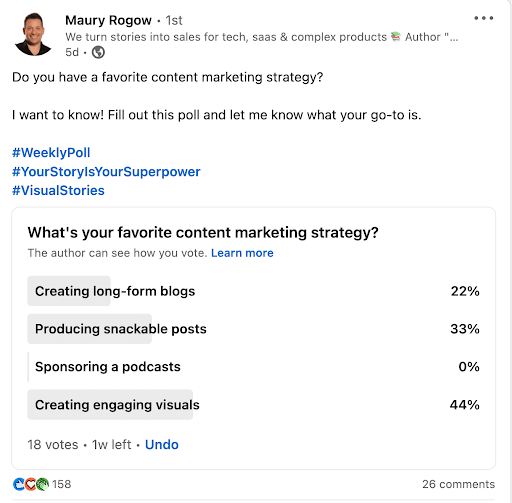
9. User-Generated Content
User-generated content (UGC) is the cornerstone of many brands’ content strategy. UGC is so powerful because it pretty much benefits everyone:
- Customers express their views about a brand or product, raising their personal online profile.
- The wider audience hears about the brand or product from real users, gaining an authentic and unfiltered perspective.
- The brand gets a huge amount of content that can be leveraged to build brand strength and loyalty.
It also facilitates a high content turnover, which means your brand can keep promoting tons of content without spending a lot.
Tactics for content marketing with user-generated content
- Incentivize your audience to create and share content about your brand by hosting UGC contests or challenges. Offer prizes, discounts, or recognition to motivate participation and increase engagement.
- Invite customers to contribute ideas, feedback, or suggestions for product features or marketing ideas through surveys, polls, or interactive Q&A sessions.
- Incorporate this feedback into your marketing campaigns, showing that you value the opinions of your customers, ultimately strengthening brand loyalty and engagement.
A little inspiration
Apple’s “Shot on iPhone” is an amazing example of UGC. In this campaign, iPhone photographers were challenged to take macro photos using an iPhone 13 Pro and iPhone 13 Pro Max. Check out a winning entry, “Sea Glass” by Guido Cassanelli, featured below. Spectacular!

10. Email Newsletters
Email newsletters remain a cornerstone of effective content marketing. Although email is one of the ‘oldest’ digital marketing channels, it is hugely popular. People use email for just about everything, including work, bills, and interactions with brands and businesses. Email is a great way to communicate directly with your audience, and it is very cost-effective too. The main challenge is breaking through the clutter and getting good open rates. Remember that your audience gets tons of emails every day, so your newsletter needs to shine through all of the others that land in customers’ inboxes.
Tactics for content marketing with email newsletters
- Segment your email list – not every customer wants (or needs) to be exposed to everything you offer unless it’s broad enough to fit them. Create newsletters that are specific to a certain time of year, feature, or customer need, like a “Holiday Season newsletter” or “Products of the Year newsletter.”
- Personalization is really important with email! Make sure your newsletter includes your customer’s name (yes, an email with “Hi Marty” instead of “Hi there” gets a lot more engagement).
- Think about the goal and KPI of your email newsletter. This will completely impact the content and CTAs (calls to action) that you include in the newsletter.
A little inspiration
We love Stacked Marketer, and especially their regular newsletter. It offers up the highlights of what’s happening in the world of digital marketing, is super shareable, and easily distinguishes itself from the myriad of other emails that land in our inboxes.
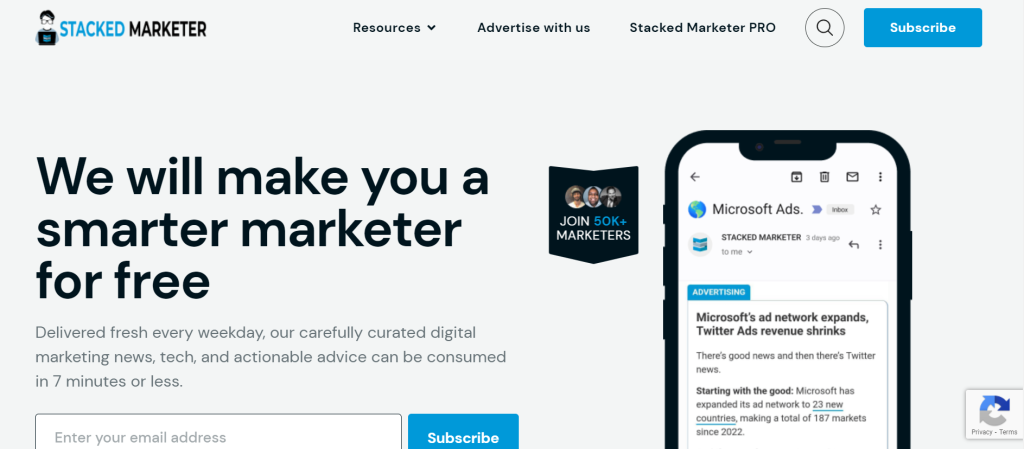
11. Social media posts
Social media platforms are an indispensable content marketing tactic and the most direct way to regularly publish content for your audience. You can get pretty granular with your targeting strategy, defining audience segments based on things like location, interests, and demographics, and targeting them with specific messages and campaigns. This, combined with the sheer scale of social media’s reach, offers you a powerful way to engage with both existing and potential customers.
Tactics for content marketing with social media
- Tailor content to each platform’s audience and format. Social media is not a one-size-fits-all online hub. What works for Facebook doesn’t work for X (formerly Twitter) or TikTok.
- Hashtags and trends can be powerful tools on social media. Make sure you’re using them effectively so that your content gets found and engaged with.
- Engage your community by posting regularly and encouraging comments and conversation. Also, comment and share others’ posts (relevant ones only of course) from your brand accounts to increase your exposure and build connections.
A little inspiration
Chipotle’s “Lid Flip” and “GuacDance” are some of the smartest TikTok campaigns we’ve seen. The first generated 240M video views by asking users to record themselves flipping a burrito bowl. As for the second, it got 430 million views in just six days by encouraging users to dance along to a song about, you guessed it, guacamole.
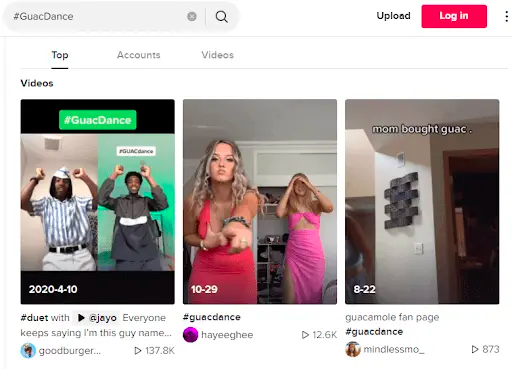
12. Live Streaming
Live streaming is not just regular video content. It lets your business interact with your audience in real-time, so it’s a great way to ride trends, create buzz and conversation, and build a community around your products or services. Nearly a third of internet users watch live streams on a weekly basis, so there’s a fair amount of demand for it. The authentic and transparent nature of live streaming particularly appeals to younger demographics who prioritize genuine interactions with brands.
Tactics for content marketing with live streaming
- Live streams are a great way to get people engaged. Don’t just talk; encourage questions and get the listeners involved. This can be done via live chat.
- Don’t be shy to monetize live streams, enabling people to show their appreciation for your content with donations. Be sure to give them a live shout-out in return. Of course, this tactic can only work once you have built a loyal following of viewers who love your content, but it’s something to aim for.
- Give exclusive behind-the-scenes glimpses or live product demos – people love to get access to content they wouldn’t get anywhere else! When the content is live-streamed, it feels even more exclusive and exciting.
A little inspiration
Ikea’s live shopping shows are amazing live streams, offering customers (and potential customers) the opportunity to see what the brand has to offer and how its products can be put to good use.
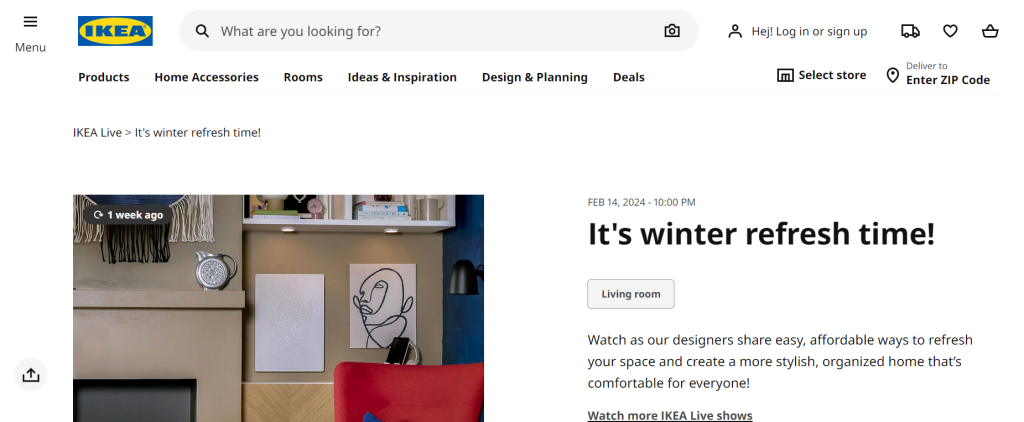
13. Advertorial Content
Advertorials are ads that take the form of editorial, journalistic content, so people are more likely to engage with them. Advertorials are a great format for narrative-driven content that takes a more article-like or storytelling form, yet like a digital ad, it can be targeted to specific audiences that are likely to be interested.
Tactics for content marketing with advertorials
- Ensure your advertorial content is scannable. Use bold, italics, and bulleted lists to draw attention to key points. If you’re unsure where to start, check out this article about crafting powerful advertorials.
- Include social proof. Testimonials, trust badges, and other social proof elements help build trust at a glance.
- Make sure your advertorials direct your customers to a single place, such as a product page on your website or a dedicated landing page, where they can take the next steps and convert (ie. buy a product).
A little inspiration
The iconic footwear company Birkenstock ran a fantastic advertorial campaign that was a journalistic investigation about feet. The paid advertorials ran on the New York Times website over three ‘chapters’, with content exploring how our feet work and how to keep them healthy. The tagline? “Ugly for a Reason”, hinting that the best footwear is comfortable and healthy, not necessarily sexy.
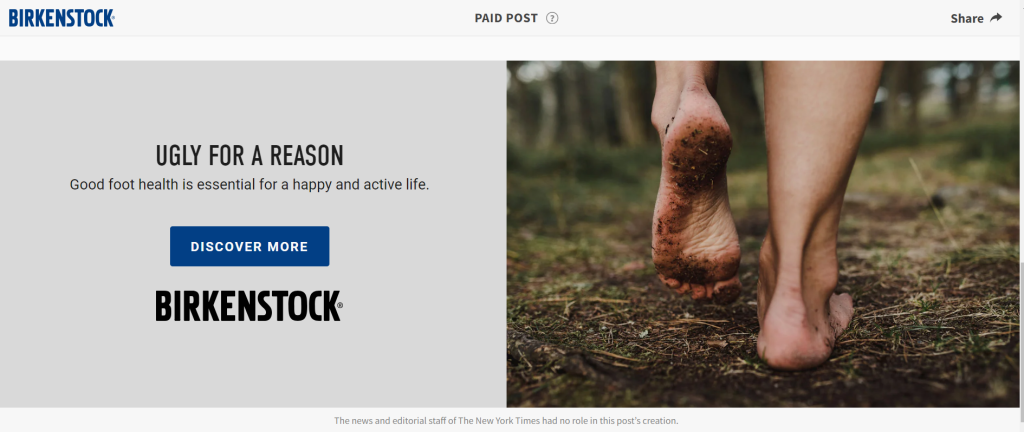
14. Micro-Content
Micro-content is bite-size, snackable content that caters to a reduced attention span. It is a quick, engaging format that encourages consumption. Think YouTube Shorts or TikTok feeds. Micro-content is ideal for social media platforms. In fact, social media algorithms tend to prioritize this type of content because it is so engaging and addictive, making it a must-have for your content marketing.
Tactics for content marketing with micro-content
- Short attention-grabbing content can have a big message. Communicate your point quickly before users can swipe or click away.
- Use platforms such as Instagram, TikTok, Snapchat, and YouTube Shorts, which are built for bite-sized engagement.
- You can also promote short snackable content with Outbrain Clip ads. Check out how to use it here.
A little inspiration
Snackable content comes in many forms. The Headspace meditation app sends a mobile notification to subscribed users each morning, featuring a very short, snackable message of inspiration in simple SMS text format. It’s a great way to keep app users engaged and remind them gently to use the app. We love receiving the messages – it always makes us feel calm and connected!
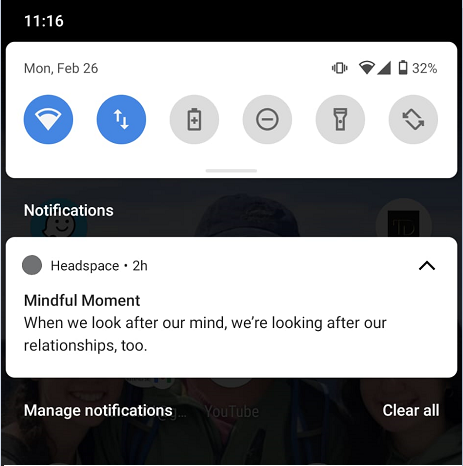
15. Evergreen Content
Evergreen content is content that has no expiry date. As such, it is useful and relevant to audiences over a long period, which is important to build up search engine rankings. Evergreen content usually takes the format of blog posts, e-books, guides, videos, and even webinar recordings. Content that has timeless relevance can help build a brand’s authority on the subject, as other websites and companies refer to it and link back to it. Thanks to a long shelf-life, evergreen content tends to deliver better ROI in the long run compared to short-lived content.
Tactics for content marketing with evergreen content
- Evergreen content should be checked once or twice a year and updated if necessary to ensure it stays relevant and reflects any changes in the industry.
- Write in a clear, straightforward manner that appeals to newbies in the industry and more knowledgeable readers. Evergreen content is usually more expansive in its topic and tone, which helps it stand the test of time.
- Make sure to relevant keywords, meta descriptions, and tags to optimize for SEO and build rankings over time.
A little inspiration
We like Pat Flynn’s guide to creating and selling an online course. This type of content never goes out of style, and though this particular guide was created in 2018, it’s just as relevant now as it was several years ago.
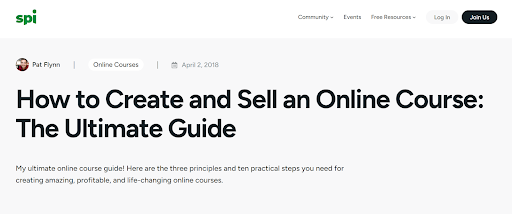
Content Marketing Tactics: A Bit of Everything
The 15 content marketing tactics outlined in this article are a blend of tried-and-true strategies and emerging trends, and all have the potential to boost your marketing efforts significantly. From newsletters and evergreen content to snackable native videos, these content marketing tactics can engage your audience on a deeper level, enhance your brand’s visibility, and drive meaningful conversions. How effective each tactic with be depends on your specific target audience, marketing goals, and industry context. So, start experimenting and continuously analyze the results to identify what combination of content marketing tactics works best for your brand.
